So, in this guide, I’ve put together a list of the five best customer data platforms and guidance on how to go about choosing a CDP.
I’ll cover:
What Are Customer Data Platforms?
Customer data platforms (CDPs) are powerful tools that give you a complete view of your customers’ behavior. By gathering data from multiple sources — like your website, mobile app, and CRM — a CDP helps you understand how customers interact with your brand across every touchpoint.
As it collects and organizes data in real-time, a CDP empowers you to make smarter decisions for both product and marketing strategies, ultimately creating a better experience for your customers.
For example, if a customer hasn’t made a purchase in a while, a CDP can analyze their past actions, like the products they’ve viewed, the emails they’ve engaged with, and how often they visit.
With these insights, you can automatically trigger a personalized message or offer to re-engage them — maybe a special discount on items they’ve browsed or a reminder about items left in their cart. This way, you’re able to reach out with content that feels relevant and timely, which increases the chances of bringing them back.
How Do Customer Data Platforms Work?
First, picture yourself as the director of marketing in a thriving ecommerce company. Your company creates a new website. You've uploaded several products, created product descriptions, and boom, your site is live.
A potential customer may start their journey with a Google search. Two days later, the customer could revisit your website and use your live chat button, but not buy. A week later, the customer opts into your email list.
In another week, the customer clicks your Facebook ad, views the product, and adds it to their cart. However, they haven't clicked “check out” and remain unconverted.
These are all individual data points capable of shaping your marketing campaigns. Often, storing these data in multiple locations, like your CRM, heat map tool, or Google Analytics, causes data silos. A CDP solves this problem.
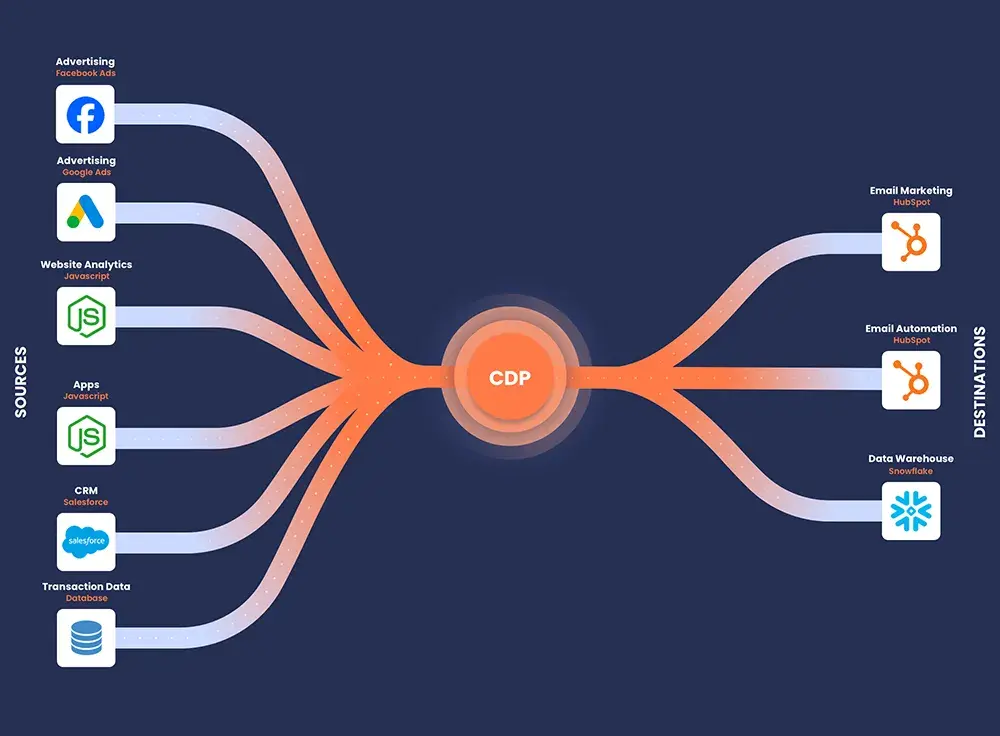
A customer data platform brings interactions from multiple data sources into one system. With a CDP as your source of truth, you can segment users, create detailed customer profiles based on behaviors, and better target customers.
CDPs also enrich your data and feed it into your campaign destinations. This builds a more personalized experience, increases customer engagement, and increases conversion rates.
Benefits of Customer Data Platforms
A CDP is an asset for a company's tech stack. It complements your existing software and makes it more effective at improving customer relationships, personalizing campaigns, and driving better business outcomes.
Below, I outline the key benefits of using a customer data platform.
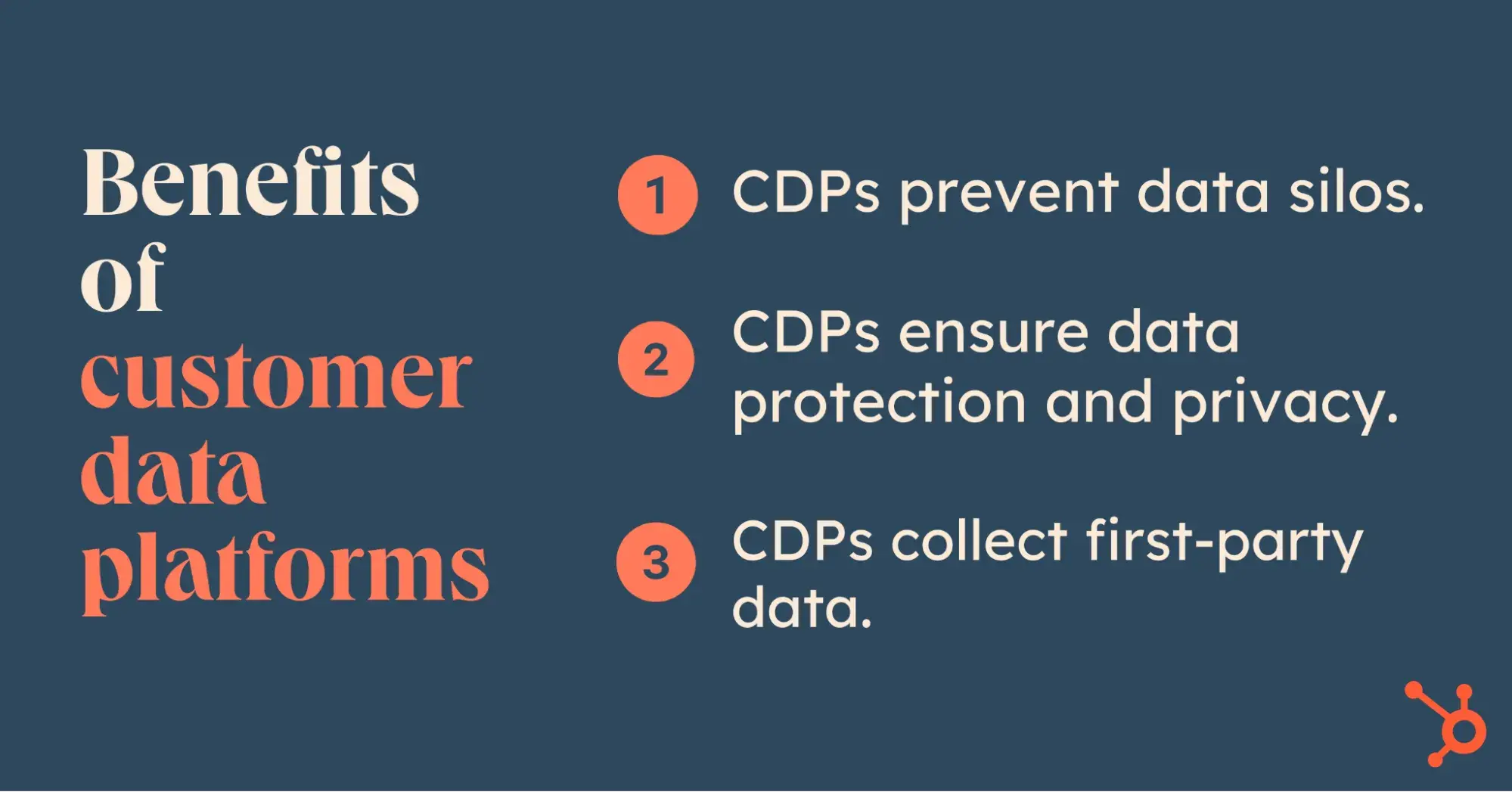
1. CDPs prevent data silos.
I think this benefit cannot be overstated. A data silo restricts information to one department and isolates it from the rest of the organization.
For example, while marketers use analytics and attribution data to understand users, sales teams focus on CRM data to close deals. These silos don’t allow both teams to collaborate and create accurate customer profiles. CDPs change that.
A CDP retrieves customer data from touchpoints like your CRM and analytics tools and stores them in one place.
2. CDPs ensure data protection and privacy.
Without a unified platform for customer data, your systems are more vulnerable to cyber-attacks and privacy breaches. When you store data in multiple locations, you may be unaware of a breach.
The good news: CDPs centralize your data.
With CDP tools, you can conduct a data audit to identify and halt breaches, keeping you and your customers safe from potential threats.
I spoke to Greg Arnold, the General Manager at Kitchen Mania, to get his take on how he ensures data protection with customer data platforms.
He shared how GDPR compliance is his biggest priority when choosing CDP tools.
“In our field, we deal with client data that extends beyond simple contact information, such as design preferences, financial limitations, and project schedules. Transparency, safe storage, and a customer's right to see or remove data are all required under GDPR.
Without this framework, we risk breaking data privacy laws, which can lead to fines (up to 4% of annual revenue under GDPR!) and a loss of trust. A certified CDP helps us responsibly track, store, and process customer data without manual workarounds.”
3. CDPs collect first-party data.
First-party data is gold for any business.
Unlike inaccurate third-party data, you can access first-party data directly from your customers with a CDP. In my experience, first-party data is so valuable because it gives you a more accurate picture of your audience.
CDPs gather first-party data as customers interact with your website, social media profiles, emails, surveys, apps, products, and every other online property you own. With this information, you can make informed business decisions.
5 Steps to Choose the Right Customer Data Platform
When I decided to implement a customer data platform, I spent weeks researching some of the best CDP companies.
With so many great options, you have to follow a strategic process to make the right decision. I followed these five critical steps to test multiple CDP tools and pick the best one.
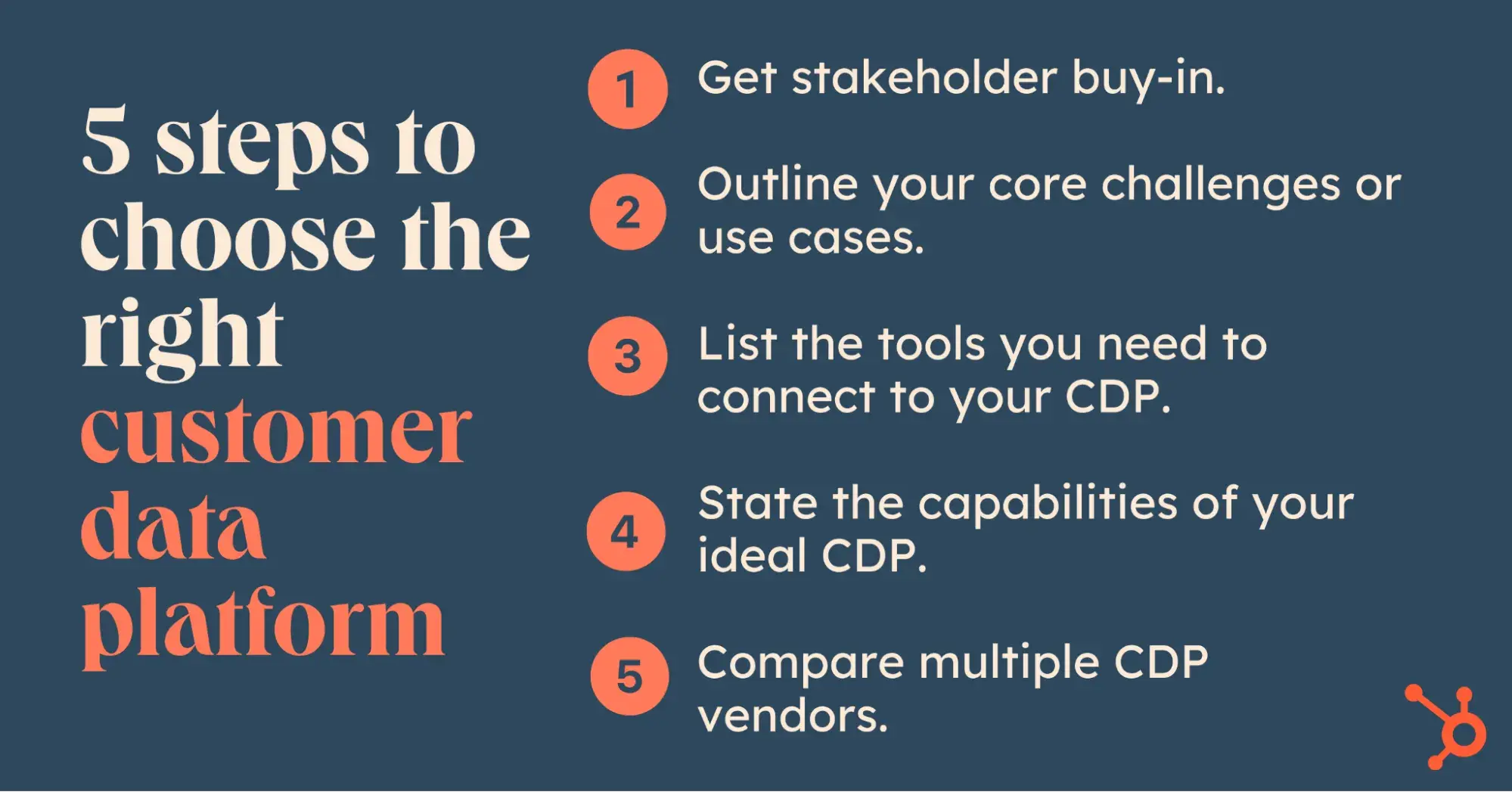
1. Get stakeholder buy-in.
CDPs ingest data from different departments of your organization. That’s why you need buy-in from internal stakeholders when choosing your CDP.
You have to coordinate with your sales, IT, customer success, marketing, and finance departments.
Including IT in the discussion seems obvious. This department knows if a CDP‘s SDKs or APIs fit your company’s tech stack.
That said, discussing a CDP with your organization as a whole means you can collect multiple types of data and integrate the right sources.
For example:
- Sales teams use a CRM platform to manage their pipeline.
- Customer success teams use onboarding tools to assist new clients.
- Marketing teams use analytics and attribution tools to track metrics like MQLs.
- Product teams use analytics data to improve the user experience of your web properties.
Getting input from these teams will help you understand what they hope to get from a CDP. I think this will also improve company wide adoption of your CDP.
Pro tip: Intricately plan each department’s role in using the CDP and tailor your pitch accordingly. Instead of a one-size-fits-all approach, give each department a complete overview of how a CDP will help with its goals.
2. Outline your core challenges or use cases.
What your company expects from a CDP likely goes beyond the general function of consolidating data. Outlining use cases specific to your brand will help you find your ideal customer data platform.
While this is the responsibility of your stakeholders, you'll need to identify common themes. This allows you to find and evaluate CDP vendors that can solve the challenges you outlined.
Some common CDP use case cases are:
- Customer data unification.
- Enhanced personalization.
- Multichannel messaging.
- Having actionable analytics.
For example, Jeffrey Zhou, the CEO of Fig Loans, told me how they created a customer data platform around the primary challenge of integrating data with minimal lag across platforms.
“At first, there was a 24-hour delay between our CRM data and email engagement metrics. This gap led to multiple instances of miscommunication with customers — one memorable case involved a customer unsubscribing via email but still receiving notifications through our app, which damaged trust.
We implemented Middleware with a five-minute data sync cycle across all channels to solve this. It was costly upfront but reduced churn by nearly 15% and immediately improved our retention metrics.”
Pro tip: Based on my experience, my best advice is to contact your peers in companies that use a CDP once you’ve identified your use cases.
Your goal is to learn about the CDP they use to address similar challenges. This will help you build a shortlist of CDP solutions.
3. List the tools you need to connect to your CDP.
If you ask me about the biggest challenge I faced when implementing a CDP solution, it was the hassle of integrating different tools into my existing setup.
Not every customer data platform is made equal.
Some CDP tools easily integrate with hundreds of tools, while others have a more complicated (and limited) integration process.
So, knowing the tools you'll connect to your CDP is important when evaluating vendors.
For instance, if one of your goals is to have a cohesive multichannel messaging strategy, you may need Google Analytics, live chat tools, business intelligence tools, and advertising tools like Facebook. The use cases I outlined in the previous step are also useful here. They can help you narrow down the tools you need.
Once you have a list of tools, you can check whether a CDP integrates with pre-existing systems. If a CDP is incompatible, you can instantly rule it out.
4. State the capabilities of your ideal CDP.
Beyond integrating with your existing tech stack, it‘s essential to consider a CDP’s core capabilities. For instance, if your company handles sensitive customer data, an ISO 27001 or SOC 2-certified CDP is ideal.
Other requirements to look out for are:
- Data governance.
- Level of quality enforcement.
- GDPR and CCPA compliance.
- Identity resolution features to get a 360-degree view of your customer journeys.
- CDPs with control over different roles and permissions.
- The volume of data you can store.
I also spoke to Arthur Favier, the founder and CEO of Oppizi, about outlining CDP capabilities. He shared a detailed breakdown of the features he considered before integrating a CDP into their setup.
“My top priorities are ensuring seamless data flows, real-time synchronization, and ease of use for our teams. I want to make sure the CDP can effortlessly exchange data with our CRM, marketing automation platform, and analytics tools through robust APIs and pre-built connectors. Real-time data syncing is crucial to keep customer profiles current and actionable.
“Additionally, I prioritize CDPs with user-friendly interfaces that empower our marketers to access and leverage customer data for campaigns without always relying on IT support.”
Pro tip: Test scalability. My most tried-and-test advice here is to always use datasets of different sizes to check whether a CDP can handle the volume of your company’s data without performance issues. You should choose a platform based on a balance of its scalability and pricing.
5. Compare multiple CDP vendors.
The final step is to find suitable vendors by assessing recommendations from colleagues, checking pricing pages, and reading CDP comparison pages.
I rely heavily on G2 and Capterra to get honest customer reviews about every platform.
Remember that all CDP tools cater to different types of users. Some may work best for small businesses and others for midmarket and enterprise companies. So, narrow your search for a CDP accordingly.
After finding some excellent CDPs, ask your stakeholders to rate the CDP‘s ability to meet their team’s requirements. They could even take the CDP for a test drive by using a free trial. From there, you can find a solution that works best.
Pro tip: Shortlist the best CDP tools and request a personalized demo for each one. Speak directly to their team and focus on learning how a CDP can handle the use cases, challenges, and needs unique to your business.
The Top 5 Customer Data Platforms
There are many customer data platforms available in the market. If you're on the hunt for your very own CDP, start your research with these five popular options.
1. Segment
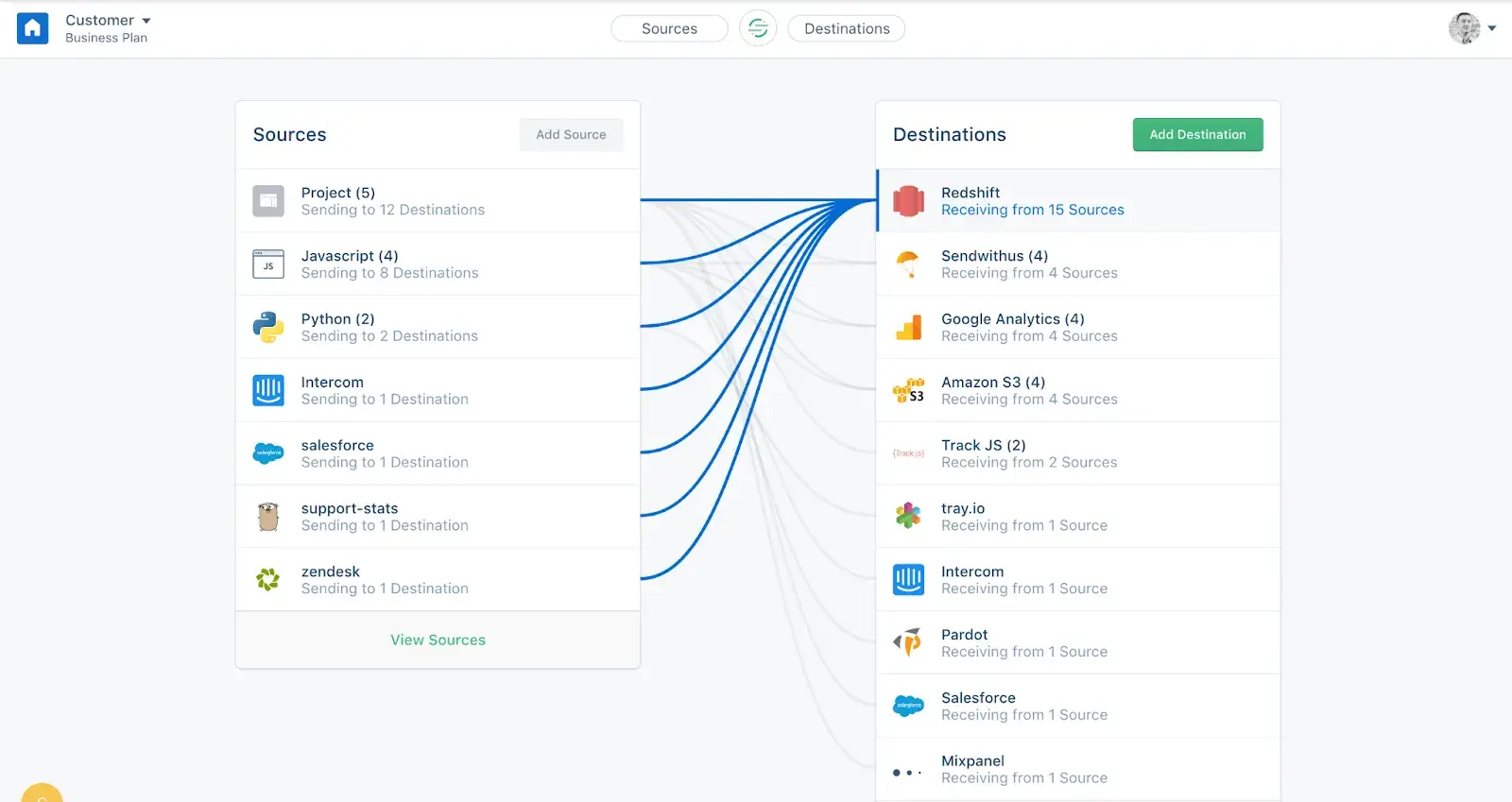
G2 Rating: 4.5/5 (500+ reviews)
Segment is one of my go-to CDP tools I recommend because it collects real-time data from 300+ channels and sources. You can capture first-party customer data from your chosen tool with a minimal setup.
One of my favorite capabilities in Segment’s CDP is its ability to stitch together customer identities across multiple platforms. This way, I could create a single view of my target customers and visualize their journey on my brand’s site or app.
Building custom audiences is another interesting feature. You can personalize your campaign by intuitively segmenting your audience based on a range of filters (like behavior, location, device, etc.) and create custom personas.
The best part? You can flexibly customize your data tracking workflows. Define specific events that matter to your brand and collect the most relevant data without any fluff.
Pricing: Segment has three pricing plans, including a free plan and paid plans, starting at $120/month per team.
2. Emarsys
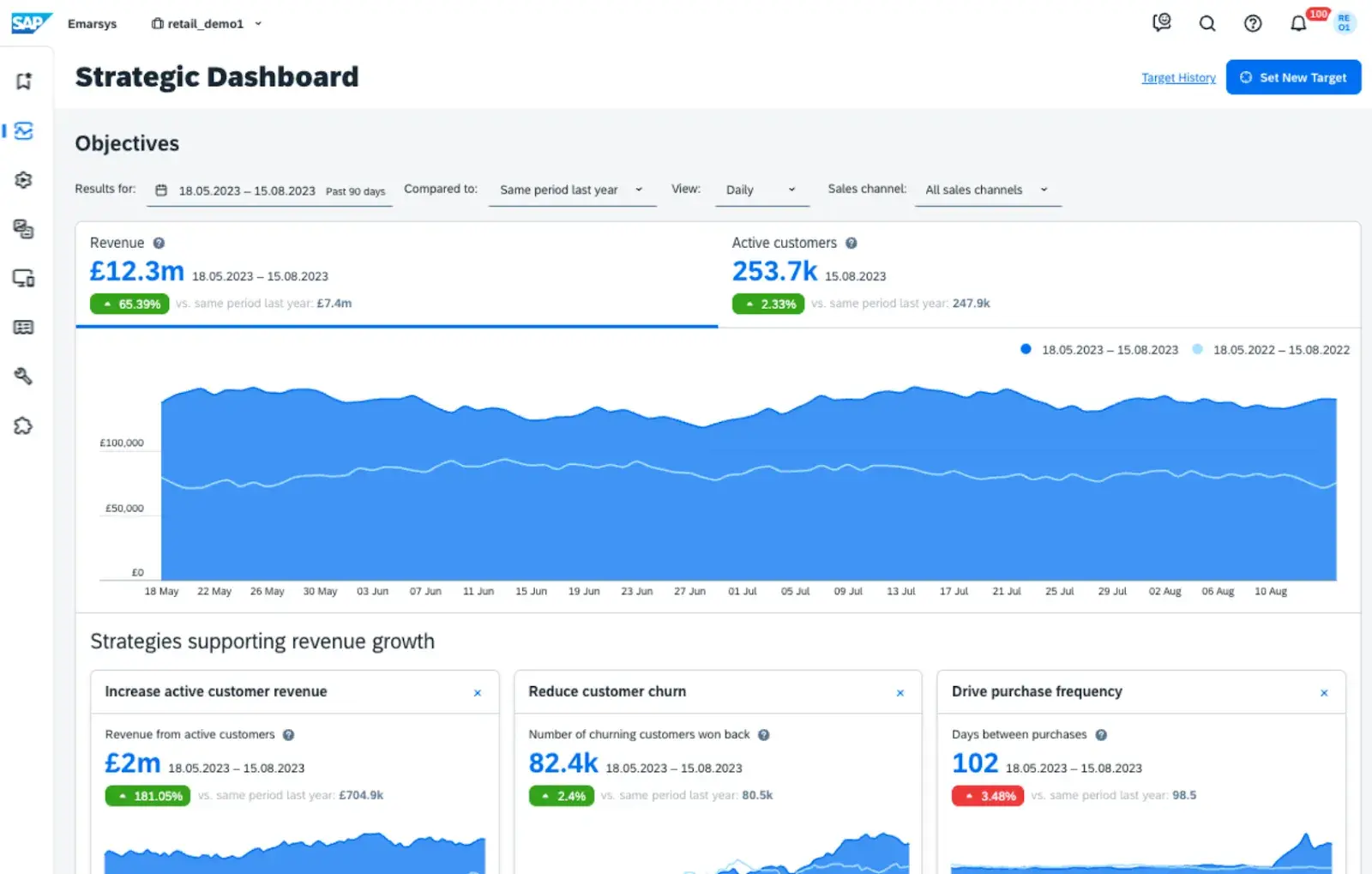
G2 Rating: 4.3/5 (400+ reviews)
Emarsys is one of the most versatile CDP tools for consolidating data from multiple sources, including offline channels. Since it covers multiple channels, I think it’s easier to execute and track omnichannel campaigns.
I particularly liked Emarsys’s AI-driven segmentation capabilities.
The tool dynamically creates customer segments based on attributes like lifecycle stage, behavior, interests, and more factors. This quick segmentation allowed you to personalize your campaign messaging without too much hassle.
For me, Emarsys's automation features give it an edge over other CDP tools. You can set up rules for repetitive workflows and get customer behavior insights directly in your inbox without lifting a finger.
Pricing: Emarsys provides pricing upon request.
3. Bloomreach
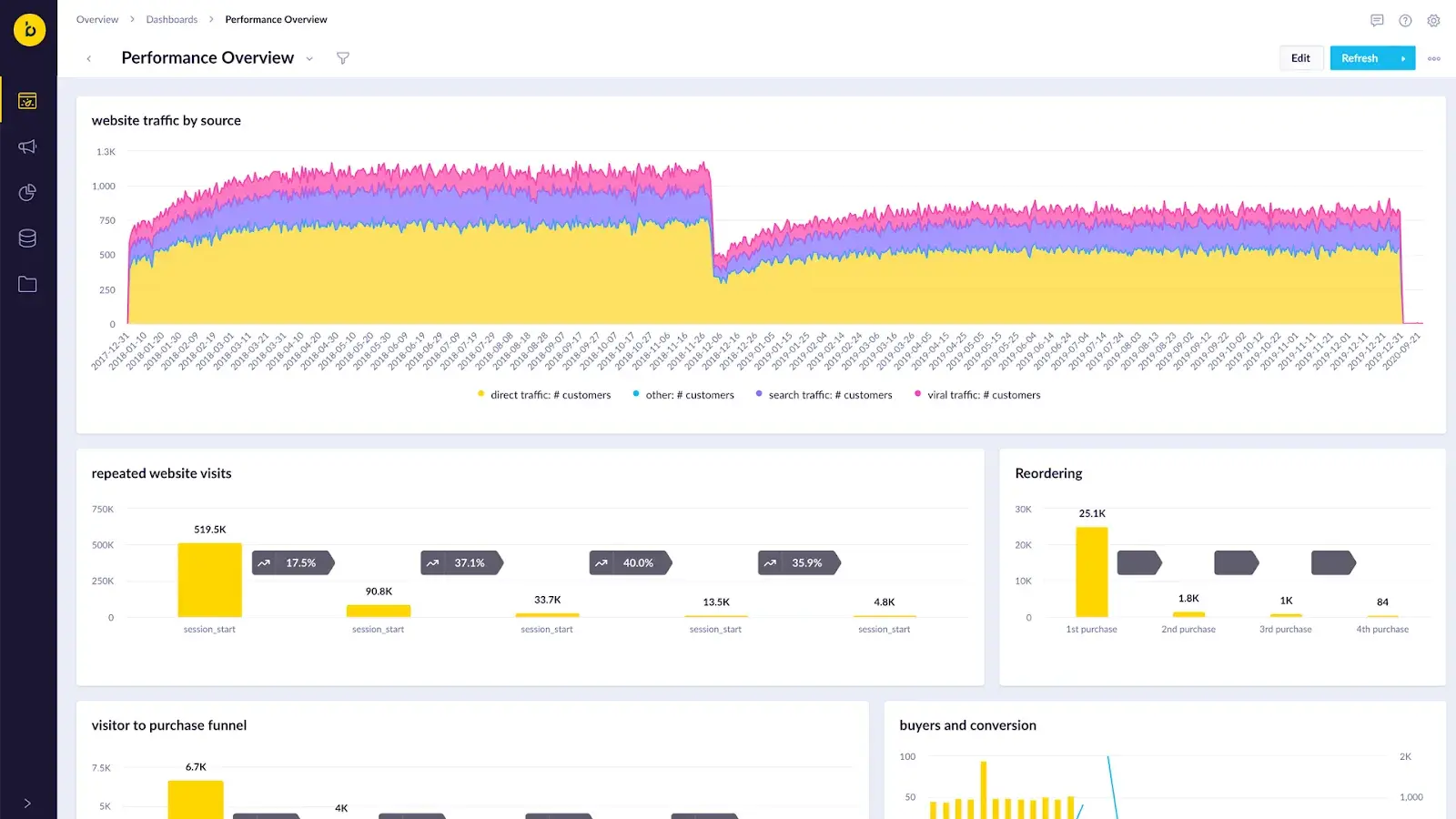
G2 Rating: 4.6/5 (600+ reviews)
Bloomreach is a more advanced customer data platform where you can integrate data lakes, warehouses, and multiple data sources. It converts basic customer data into business intelligence to drive growth for your team.
I like that as a marketer, you don’t have to get tangled in the technicalities of data processing. You can simply feed the data to Bloomreach, and the platform analyzes it to present actionable insights about your customers.
The platform uses historical and real-time data to create detailed reports about your customers.
I found this platform highly useful for ecommerce businesses since Bloomreach offers multiple solutions for online store owners.
Pricing: Bloomreach provides pricing upon request.
4. Optimove
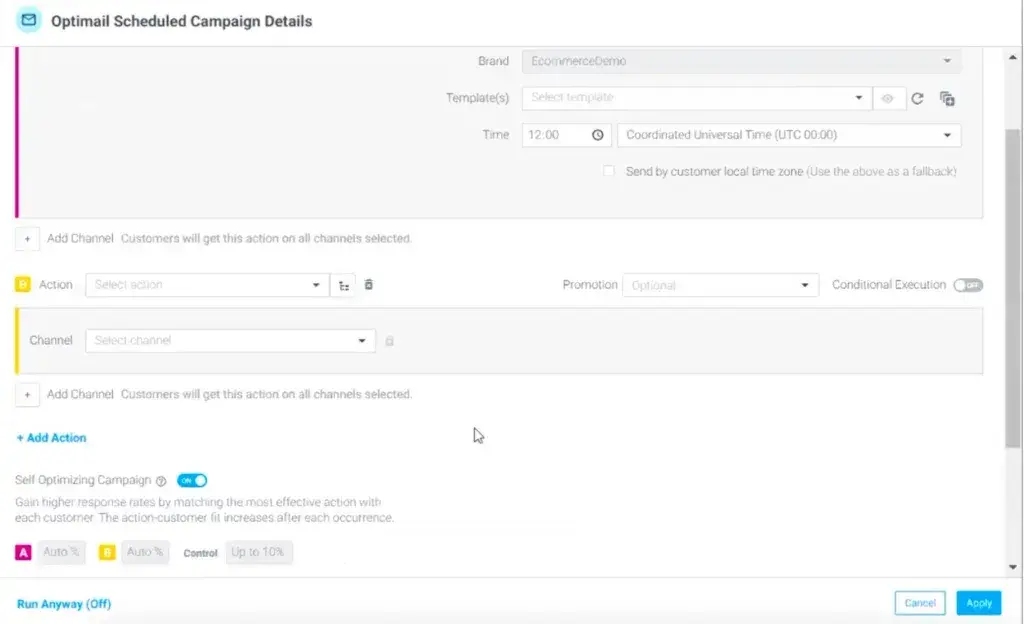
G2 Rating: 4.6/5 (170+ reviews)
Optimove is a relationship marketing hub with a built-in CDP platform. Unlike other CDP tools, Optimove isn’t a dedicated customer data platform. However, it provides a consolidated view of the customer by combining first-party data, third-party data, and campaign response history.
When I tested this platform, I particularly liked OptiGenie — an AI assistant designed to predict customer behavior. This predictive modeling tool analyzed past data to give me suggestions for optimizing my campaigns.
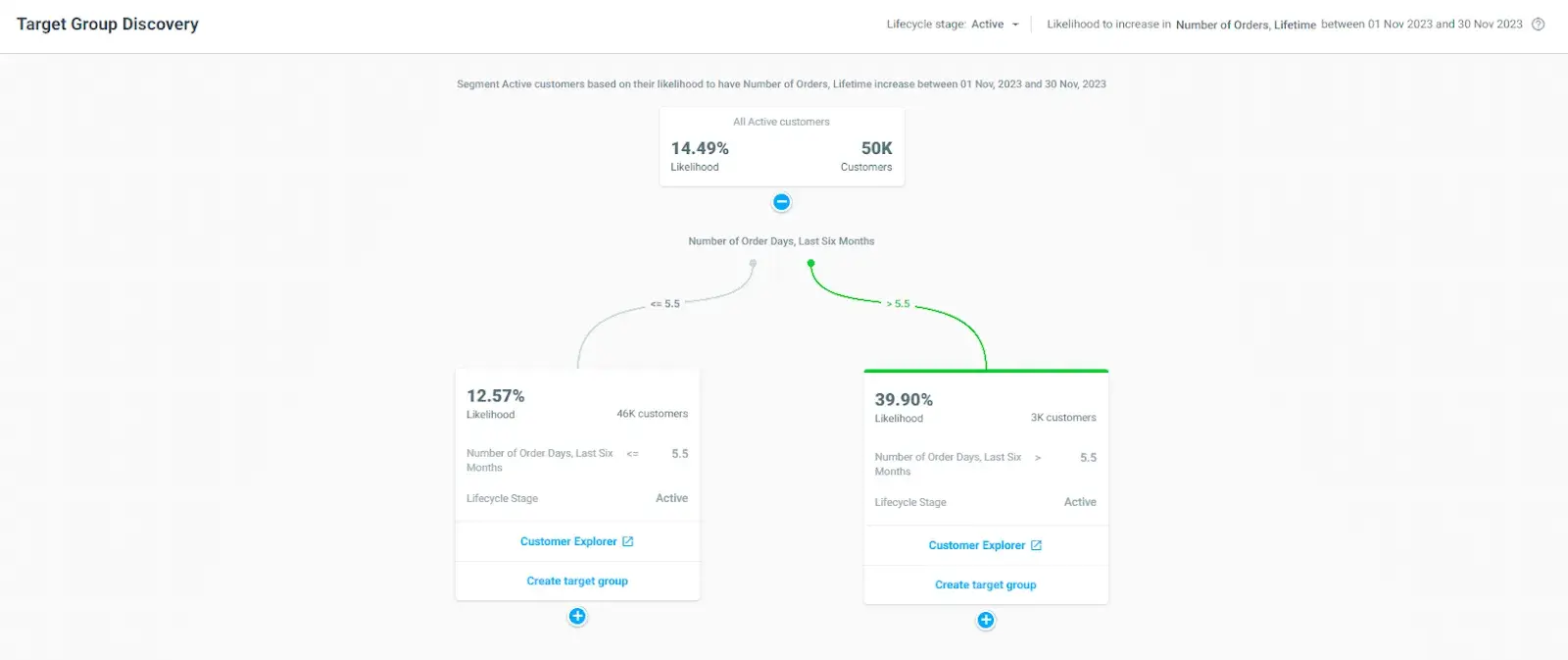
I also used OptiGenie to get a pulse of my customers through surveys. I added this data to the platform and asked questions to interpret it quickly.
Pricing: Optimove provides pricing upon request.
5. Tealium AudienceStream CDP
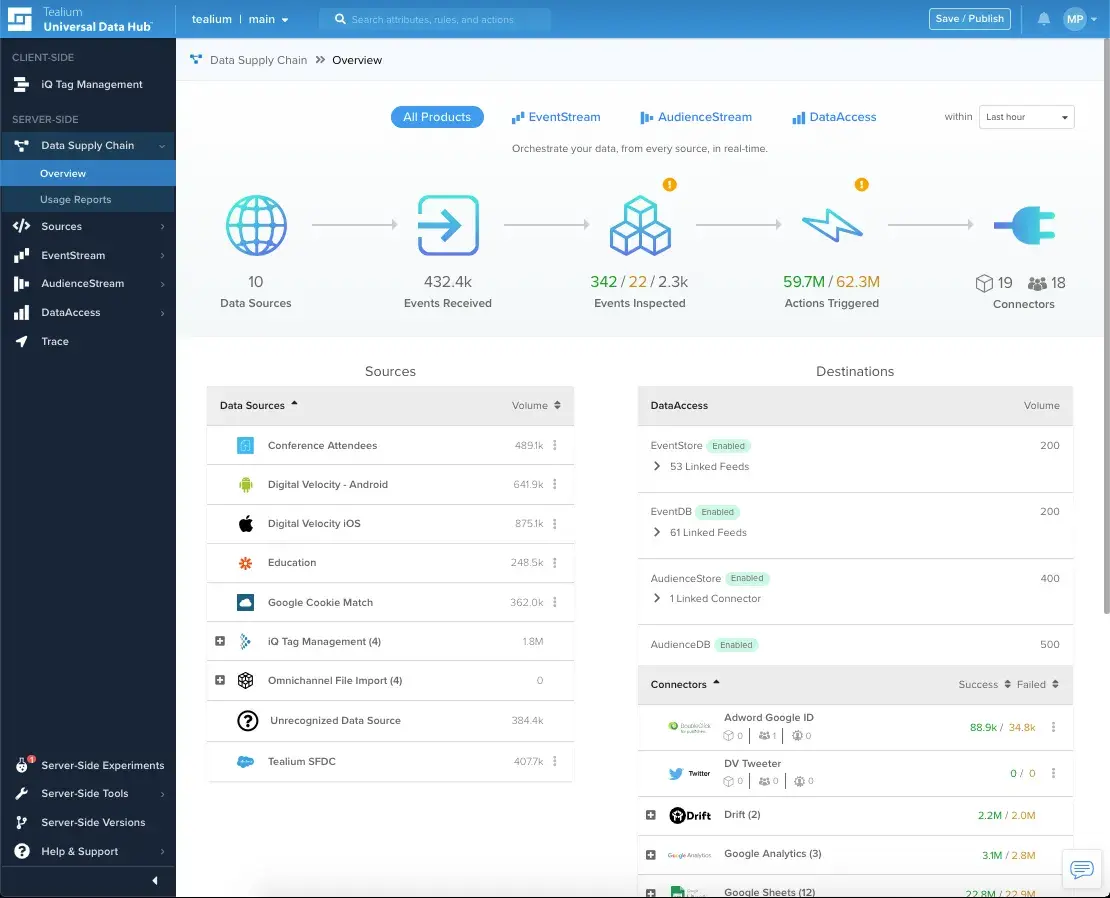
G2 Rating: 4.3/5 (300+ reviews)
Tealium AudienceStream offers a CDP with predictive insights. That means you get a clear understanding of your customers in the present and the future.
I love that you can use Tealium’s segmentation tool to create customer profiles. I was amazed to see how this tool continuously evolves these profiles based on new data and insights it collects from online and offline channels.
What’s more, you can use its predictive insights to create high-value audiences. These profiles were based on the likelihood of conversion or churn. Once you have the profiles, your can plan your campaigns around these attributes to maximize the impact.
You can also enrich this customer data using Tealium’s API. This enriched data will give you a more holistic look at customer interactions and enhance decision-making.
Pricing: Tealium AudienceStream CDP provides pricing upon request.
What to Look for in a Customer Data Platform
You may be in the market to buy a CDP. Or perhaps your company can build the core functionalities of a CDP.
Whichever route you choose, you'll need to make sure your system has access to the following essential features.
When I chatted with AJ Liddell, Data and Operations Analyst at Gilbert & Cook, on this subject, he shared sage advice on how to choose CDPs. Here’s what Liddell said:
“My biggest recommendation to anyone selecting a CDP is to define business use cases, data needs, and processes around them before evaluating any platforms. The biggest concern when implementing a new platform is that it will not strategically align to the business’s needs and will not be adopted by end users leading to a sunk technology cost.”
Let’s break down the five core elements of the best CDP tools to look for.
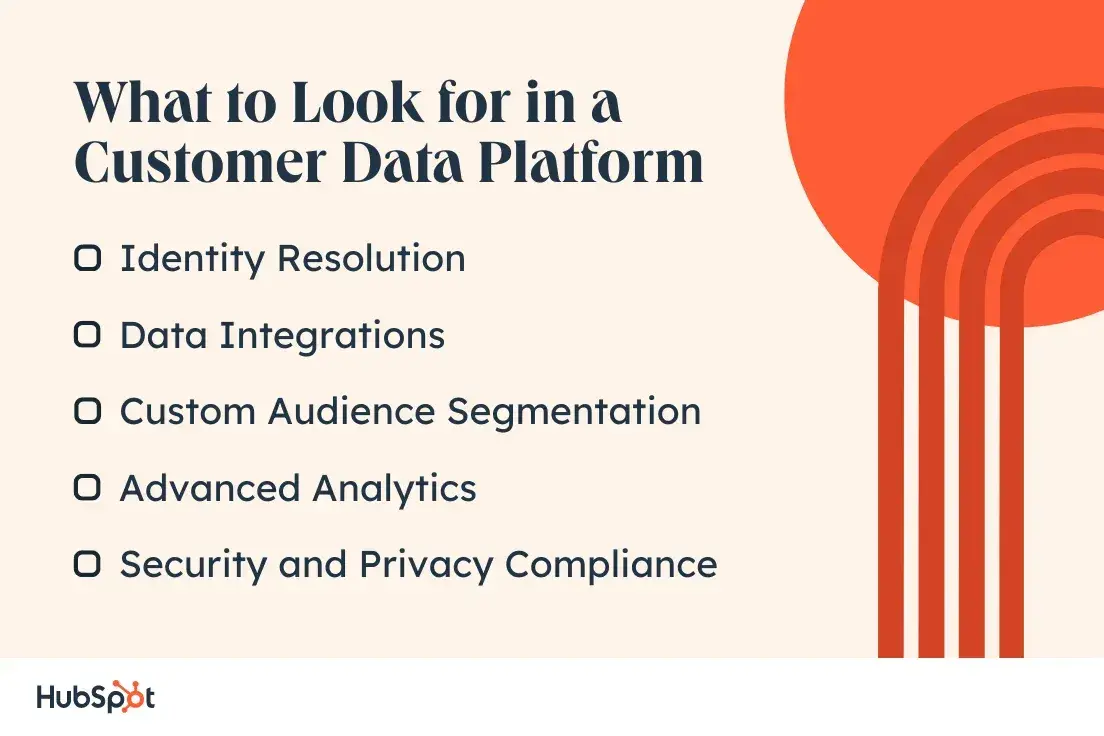
1. Identity Resolution
Identity resolution is the ability of a CDP to understand how customers interact across multiple channels, devices, and touchpoints.
This integral function allows CDPs to use a customer's history to create a single profile of a user.
2. Data Integrations
The best customer data platforms unite information from your ad-tech and mar-tech stacks. Therefore, your chosen CDP should be able to ingest and activate data from your current tools in real time.
Zhou gave me another interesting insight into data integrations for CDP. He explained how standardizing data from different sources is challenging. Likes and shares are engagement-based data from social media, whereas the CRM focuses on transactional data.
These formats clashed and often required manual cleaning, which consumed hours each week.
“We made an investment in a custom data pipeline to automate this process, matching incoming data with the structure of our CRM,” he shared. “By improving campaign personalization by 25% and saving us about 12 hours of manual work each month, this investment has increased customer interactions and engagement. These fixes weren’t cheap, but the improvements in customer trust and engagement have been well worth it.”
3. Custom Audience Segmentation
The best CDPs allow you to create custom audiences using any data point. With this, you can build personalized campaigns that target customers across social media, email, and search engines.
Spencer Romenco explained to me that CDPs help sync customer data in real time, making customer segmentation more powerful.
The result? Romenco’s team can deliver targeted messaging quickly to drive conversions.
“We segment customers within the CDP based on real-time actions and then push those segments directly into the CRM with specific workflows attached. This allows our team to track how customers move through different stages of their journey and adjust in real time. If a high-value lead starts engaging with new products, the CDP syncs this data immediately, updating CRM attributes and kicking off targeted follow-up actions or lead-nurturing campaigns.”
4. Advanced Analytics
Marketers usually have more data than they need.
So, when building or buying a CDP, you want one that's equipped with advanced data analytics features and AI-powered analysis.
This helps marketers create dashboards containing relevant metrics. Make sure you can export this data to share with team members.
5. Security and Privacy Compliance
The biggest privacy sanctions have resulted in fines of over $1 billion.
To make sure your company doesn't fall into hot water, make sure your CDP is secure.
Confirm a CDP's security and privacy standards by checking if they have certifications like ISO 27001, ISO 27017, ISO 27018, CSA Star, and GDPR Seal.
Refined Data Is Usable Data
Without refined data, poor customer engagement and wasted marketing budgets can quickly become the norm.
I see CDPs as the solution to this — they make well-processed data a central part of a company’s operations. CDPs are essential for any business aiming to harness first-party customer data, build accurate customer profiles, launch personalized marketing campaigns, and ultimately drive revenue.
I hope this blog has helped you start exploring which CDP will be the best fit for your business.
Editor's note: This article was originally published in November 2022 and has since been updated for comprehensiveness.
CDP


.webp)

![Customer Data Integration: A Complete Guide [Expert Tips & Examples]](https://53.fs1.hubspotusercontent-na1.net/hubfs/53/customer-data-integration-1-20241218-9529716.webp)
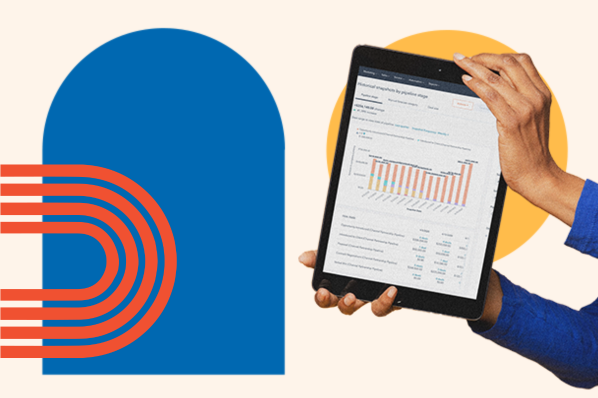




![What Is an Identity Graph? [The Plain-English Guide]](https://53.fs1.hubspotusercontent-na1.net/hubfs/53/identity-graphs.jpg)

